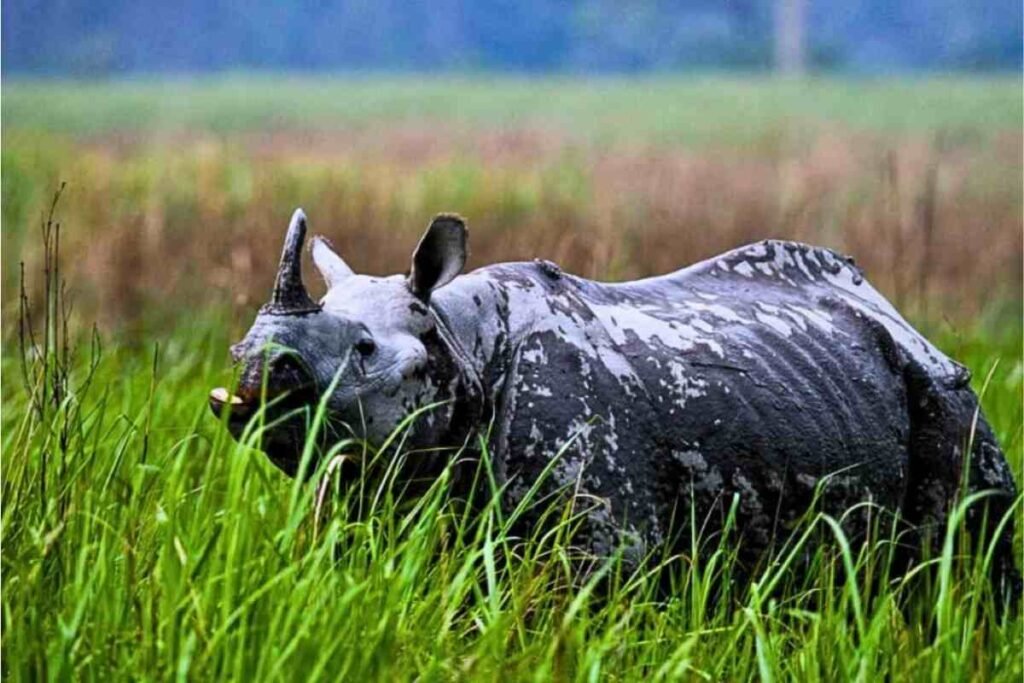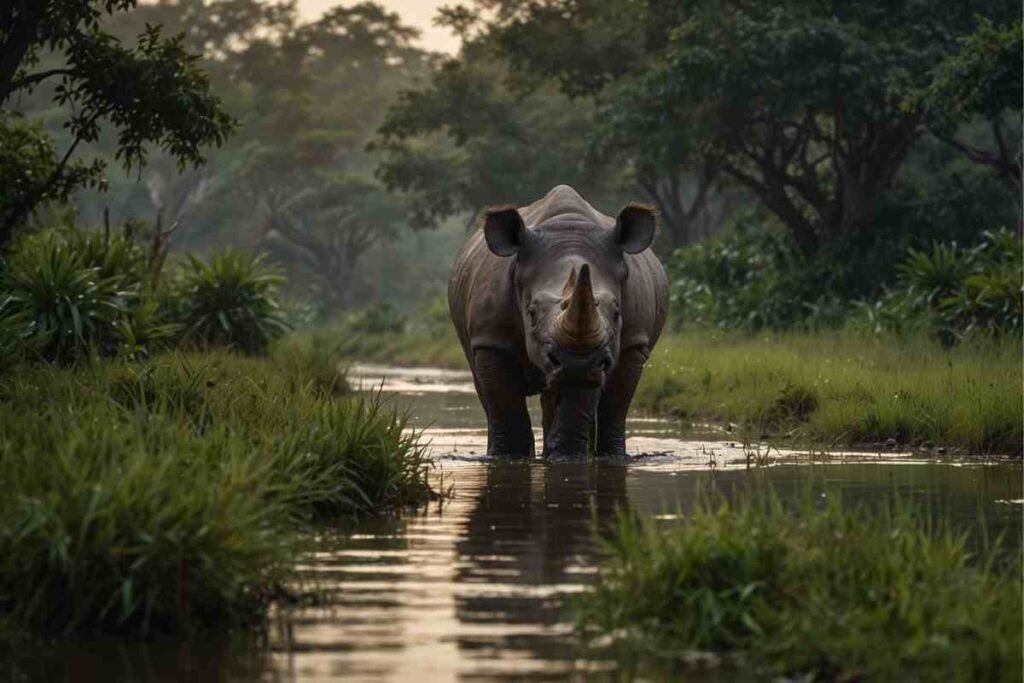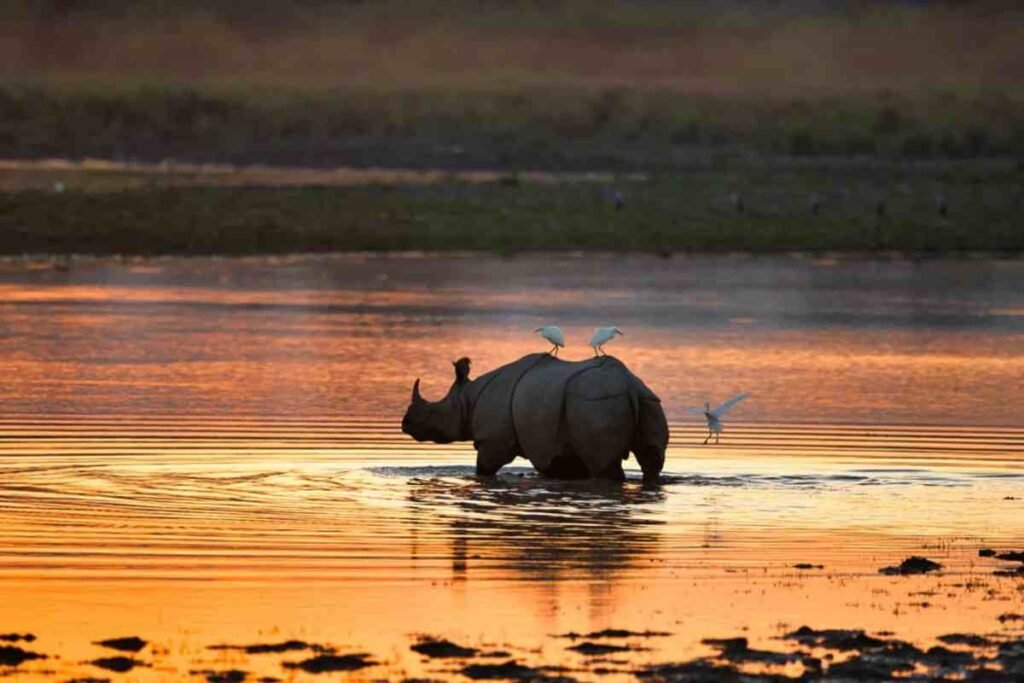The one-horned rhinoceros, also known as the Indian rhino, is one of the most iconic symbols of wildlife conservation.
These majestic creatures, known for their distinctive single horn and armor-like skin, are primarily found in Kaziranga National Park in Assam, India.
If you’ve ever wondered, One horned rhino is found in which national park? Then must read this whole article.
Why Kaziranga National Park is Where One Horned Rhino is Found

If you’ve ever wondered, One horned rhino is found in which national park? the answer is clear Kaziranga National Park. Known for its lush ecosystems, Kaziranga National Park is the perfect habitat for the one horned rhino.
The one horned rhino is found in which national park? The answer is undoubtedly Kaziranga, a symbol of successful wildlife conservation.
Kaziranga National Park is the definitive answer to the question, One horned rhino is found in which national park? This protected area offers:
- Floodplain Grasslands: A mix of tall grasses and wetlands, perfect for grazing and wallowing.
- Proximity to Brahmaputra River: Ensures year-round water availability.
- Strict Conservation Measures: Anti-poaching laws and local involvement have made Kaziranga a rhino haven.
Amazing Facts About One-Horned Rhinos in Kaziranga
- Kaziranga is the Home to the Largest Population of One Horned Rhinos: If you’re wondering, one horned rhino is found in which national park, Kaziranga National Park is home to over 2,600 rhinos, the largest population in the world.
- Armor-Like Skin: The one horned rhino’s thick skin serves as armor, helping protect it from predators. Kaziranga National Park provides a safe space for these unique animals.
- Horn Regrowth: The one horned rhino’s horn is made of keratin and can regrow if broken, a fascinating fact that adds to their resilience in Kaziranga National Park.
A Conservation Success Story for One-Horned Rhinos
In the early 1900s, fewer than 200 one-horned rhinos were left in the wild, with their survival at risk. Thanks to dedicated conservation efforts, the population has rebounded, and today, over 3,700 one-horned rhinos are found in the wild, including in Kaziranga National Park, where a significant number thrive.
The One-Horned Rhino’s Massive Size: Adult males weigh up to 2,200 kg, equivalent to three compact cars! Despite their size, they can run at speeds of up to 40 km/h.
One-Horned Rhino Breeding Patterns: Females give birth every 3–4 years after a 15-16 month gestation period. Calves stay with their mothers for up to 18 months.
One-Horned Rhinos Are Vulnerable to Predation: While adults have few natural predators, young calves may fall prey to tigers in Kaziranga’s dense forests.
One-Horned Rhinos Have Strong Smell and Hearing: Despite their poor eyesight, rhinos rely on acute senses of smell and hearing to detect danger and locate food.
Conservation Efforts in Kaziranga: Protecting One Horned Rhinos

Conservation efforts in Kaziranga focus on protecting one-horned rhinos through strict anti-poaching measures and habitat preservation. These efforts have helped increase the rhino population and ensure their safety in the park.
Kaziranga’s success is rooted in robust conservation strategies, including:
- Anti-Poaching Units: Armed patrols and surveillance systems.
- Community Involvement: Local communities are engaged in eco-tourism and rhino protection.
- Rehabilitation of Habitats: Floodplains and grasslands are regularly restored to support wildlife.
Other National Parks Where One Horned Rhino is Found
- Pobitora Wildlife Sanctuary, Assam – Highest rhino density.
- Manas National Park, Assam – A UNESCO World Heritage Site.
- Chitwan National Park, Nepal – Home to nearly 600 rhinos.
- Orang National Park, Assam – Smaller population in a lush setting.
Best Time and Tips to Visit Kaziranga: See Where One Horned Rhino is Found

The best time to visit Kaziranga is from November to April, when the weather is pleasant and wildlife sightings are high.
To increase your chances of seeing one-horned rhinos, go on early morning safaris and follow the park’s guidelines.
Safari Options
Jeep Safari: Covers large areas of the park.
Elephant Safari: Offers a closer view of rhinos in their natural habitat.
How to Get There
By Air: Closest airport is Jorhat (97 km).
By Train: Furkating Junction is the nearest railhead.
Conclusion
If you’ve been asking, One horned rhino is found in which national park, Kaziranga National Park is the ultimate destination.
This sanctuary, known for its dedication to rhino conservation, is where the one horned rhino is found in large numbers.
By visiting Kaziranga, you not only witness the beauty of these majestic animals but also contribute to their protection.
FAQs
Why is Kaziranga National Park ideal for one-horned rhinos?
Kaziranga’s combination of grasslands, wetlands, and river systems provides the perfect environment for grazing, water access, and shelter, making it an ideal home for one-horned rhinos.
How is Kaziranga helping in rhino conservation?
Kaziranga uses armed patrols, community involvement, and habitat restoration to actively protect and grow its rhino population, making it a global conservation success.
What other animals can be seen in Kaziranga National Park?
Besides one-horned rhinos, Kaziranga is home to elephants, wild water buffalo, swamp deer, tigers, and over 500 species of birds.
Can tourists see rhinos easily during safaris?
Yes, during the safari season (November to April), rhino sightings are common, especially during early morning or late afternoon jeep or elephant safaris.
Is Kaziranga safe for tourists?
Yes, Kaziranga is a well-managed park with trained guides, strict safety protocols, and organized safari services, ensuring a secure and enjoyable experience for visitors..